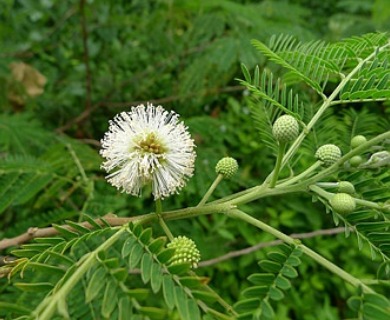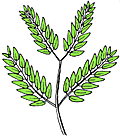Koa Haole
Leucaena leucocephala
Pea family (Fabaceae)
Post-Cook introduction
Koa haole (foreign koa), or leucaena, is a vigorous shrub or small tree of dry lowlands throughout the Hawaiian Islands, also of larger size on moderately wet sites. This naturalized species is characterized by twice- leaves with numerous small gray green many flowers in whitish round balls 3⁄4–1 inch (2–2.5 ) across the spreading threadlike and many clustered dark brown flat pods. Mimosa subfamily (Mimosoideae).

©2011 John Tann
Leaves twice- (), 4–8 inches (10–20 ) long, with 3–10 pairs of lateral axes (), the axes gray green and finely hairy, with swelling at base. 10–20 pairs on each lateral axis, stalkless, narrowly oblong or lance-shaped, 5⁄16–5⁄8 inch (8–15 ) long and less than 1⁄8 inch (3 ) wide, short-pointed at and unequal or oblique at short-pointed base, thin, gray green and nearly hairless, slightly paler beneath, folding upward together at night.
Flower heads are whitish round balls 3⁄8–1⁄2 inch (10-13 ) across on stalks of 3⁄4–1 1⁄4 inches (2–4 ) in clusters (racemelike) at ends or sides of twigs. Flowers are many, narrow, stalkless. Each individual flower 5⁄16 inch (8 ) or more in length has a tubular greenish white hairy five- more than 1⁄16 inch (1.5 ) long, five narrow greenish white hairy petals nearly 3⁄16 inch (5 ) long, 10 threadlike white about 5⁄16 inch (8 ) long, and slender stalked nearly 1⁄4 inch (6 ) long with narrow green hairy and white
Pods many oblong, 4–6 inches (10–15 ) long and 5⁄8–3⁄4 inch (15–19 ) wide, flat and thin, with raised border, dark brown, short-pointed at narrowed into stalk at base, and minutely hairy. Many hang down in a cluster from the end of the stalk, splitting open on both edges. Seeds are many in a central row, beanlike, oblong, flattened, pointed, shiny brown, 5⁄16 inch (8 ) long. Flowering and fruiting nearly through the year.
Wood hard and heavy ( gr. 0.7); sapwood light yellow and heartwood yellow brown to dark brown. It makes excellent firewood and charcoal and has potential as a source for pulp and paper, roundwood, and construction material. The seeds, after being softened in boiling water, are strung into necklaces, leis, table mats, purses, and curiosities for tourists.
The plants contain a poisonous alkaloid called mimosine, which can cause the loss of long hair in humans, horses, and some other animals, and sickness in ruminant animals. Mimosine is easily leached from leaves by soaking in water, and cooking will also remove it.
The trees are easily propagated from seeds or cuttings and coppice well. However, because of the hard seed coat, the seeds should be treated or scarified first. In some countries this species has been used for coffee shade, cacao shade, and hedges. Being hardy it can be planted in pastures, to be followed afterwards by timber trees. In some areas the trees are planted and managed for fuel or charcoal on a short rotation of 3 or 4 years between cuttings. Young plants have been harvested also as a green manure for tea and coffee plantations. In the Far East this is grown to rebuild the soil and as a forage crop.
Abundant as a weed in dry lowlands of Hawaii, often forming dense thickets in lowlands and lower mountain slopes of 2500 ft (762 ) altitude. According to Degener, this species was unknown in Hawaii in 1864, but reported as “frequent” 20 years later. It is reported that seeds have been broadcast from airplanes.
Special areas
Waimea, Koko, City
Range
Native apparently in southeastern Mexico but the distribution has greatly extended by introduction beyond. Now widely naturalized through New and Old World tropics. Naturalized in Hawaii, Mariana Islands, southern Texas, southern Florida, and Puerto Rico and Virgin Islands. Planted also in California.
Other common names
false koa, lili-koa, ekoa, ipilipil, wild tamarind; zarcilla (Puerto Rico); tantan (Virgin Islands); tangan-tangan (Guam); taln tangan (N. Marianas); telentund (Palau); ganitnityuwan tangantan (Yap); tangan-tangan (Marshalls); lopa-samoa (Am. Samoa)
Botanical
Leucaena glauca Benth.







